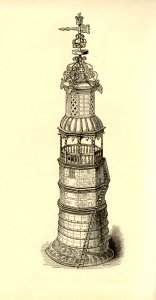click on images to enlarge
SILVER SALT
(largely based on Old English Plate by Wilfred Joseph Cripps, sixth Edition, John Murray, London,
1899)
The salt was the principal article of domestic plate in English houses of whatever degree. The massive
salt cellar, which adorned the centre of the table, served to indicate the importance of the owner and
to divide the lord and his nobler guests from the inferior guests and menial, who were entitled to places
'below the salt' and at the lower ends of the table only. It seem rather to have served this purpose than to
hold salt for the meal, a supply of which was usually placed near each person's trencher in a smaller
salt-cellar, called a 'trencher salt'.
The great salt was , therefore, an object of considerable interest, and it was often of great
magnificence and of curious device (... in the shape of a dog, an olifant, a dragon, a lion ...).
Fifteenth century wills mention salts of every shape and size and kind. Salts square, round, plain,
high, low, with covers and without, in silver and silver gilt are found.
The All Souls'College, Oxford has a fifteenth century salt called the 'Huntsman salt' from the
standing figure bearing upon his head the receptacle for salt (a rock-crystal box with hinged lid).
The salt use is widely illustrated in Sixteenth century treatise containing suggestion on how the
chief salt-cellar should be placed (... in the middle of the table according where the principal
sovereign shall seat ... the second salt at the lower end ... ) or how to use the salt (only with 'kleen
knife' and avoiding to dip the meat into the salt-cellar). |
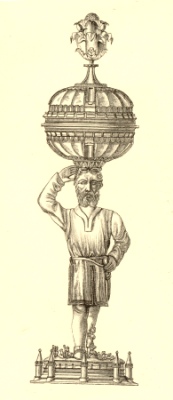 |
| |
the 'Huntsman salt' at the All Souls' College, Oxford
|
There are four pattern of Old English salt-cellars of which examples have been come down to our time.
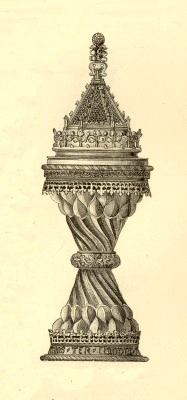 |
First come the hour-glass salts of the reigns of Henry VII and
Henry VIII (five or six hallmarked and a pair undated). Two are at Oxford, Corpus Christi
College and New College. The New College salt is dated 1493 and was given by Walter Hill.
It serves well as an illustration of these beautiful salts.
Another pair of this class of salt are of 1518 and 1522 and are in the possession of the
Iron-mongers' Company in London. They are six-sided in plan, with raised lobes alternately ornamented
and plain.
|
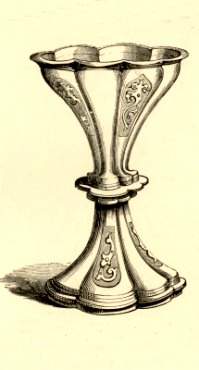 |
|
The New College, Oxford, salt dated 1493
|
|
the six sided Iron-mongers' Company, London, salt
|
By the middle of the sixteenth century we come to the second type, and the earliest of this class again is
at Corpus Christi College, Oxford. It is a 1554 cylindrical standing salt ornamented with repoussť
and engraved work in a pattern formed of three principal cartouches with central bosses, the
intervals filled with foliated scrolls. The cover is surmonted by a stuatuette of a boy with a staff
of shield
These cylindrical salts occur oftener than the square ones and an example is one in the
possession of the Corporation of Norwich, given by Peter Reade and made in Norwich in 1569.
The Hammersley salt at Haberdashers' Hall is of 1595 and it presents a drum repoussť with pastoral subjects contrasting
with the conventional decoration common in this period.
The square type is represented by the 1569 salt belonging to the Vintners' Company.
It has four panels at the sides, in bold relief, with four female figures representing Virtues and
the cornice and foot boldly molded and richly embossed.
The whole rests on four sphinxes and the cover is surmounted by a female figure standing on a vase.
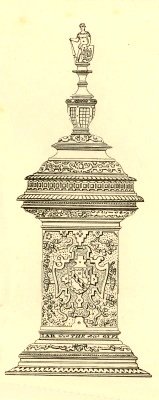 |
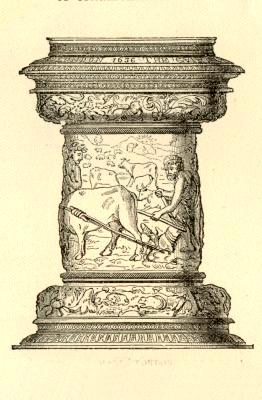 |
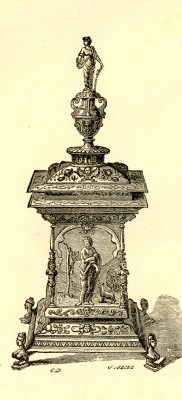 |
|
the Corporation of Norwich cylindrical salt
|
the Haberdashers' Hall 1595 salt cellar
|
the 1569 Vintners' Hall salt-cellar
|
At the very end of the sixteenth century we find a circular bell-shaped salt (or spice box) in three
tiers or compartments. This shape was much in fashion but only for a few years. The example
illustrating this shape belongs to Christ's Hospital, London and is very representative of its period.
The two lower compartments form salt-cellars, and the upper one serves as a pepper-castor.
|
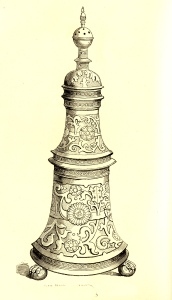 |
| |
the 1607 Christ's Hospital, London, salt
|
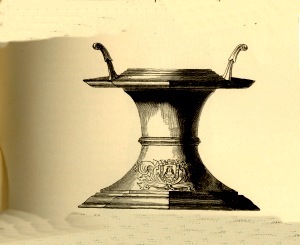 |
Next comes the simple and well-known form of salt from 1638 (the date of one of the earliest known) to 1685,
when circular examples as this in the in possession of the Worshipful Company of Mercers was made.
Other similar salt-cellars of this period are square or octagonal.
It will have been observed how carefully the earlier salts were covered to preserve cleaness of the
salt, and perhaps to prevent the introduction of poison; in these later ones the small projected
arms were for supporting a napkin with which it now became usual to cover the salt-cellar with the
same object.
|
|
Mercers' Hall, London, 1685 octagonal salt
|
|
Last of all must be described the curious and unique salt-cellar built 1698 in the shape of a
lighthouse. It has three storeys: the upper one empty, the next with a lid perforated for
pepper and the lowest as a large box, empy as the uppermost.
an elaboration of Giorgio Busetto for A Small Collection of Antique Silver an Objects of Vertu

www.silvercollection.it |
This is an article for A Small Collection of
Antique Silver and Objects of vertu,
a 1000 pages richly illustrated website offering all you need to know about
antique silver, sterling silver, silverplate, sheffield plate, electroplate silver,
silverware, flatware, tea services and tea complements, marks and hallmarks, articles,
books, auction catalogs, dictionary of silver, famous silversmiths (Tiffany, Gorham,
Jensen, Elkington), history, oddities ...
SITE MAP - HOME PAGE |
|
|









